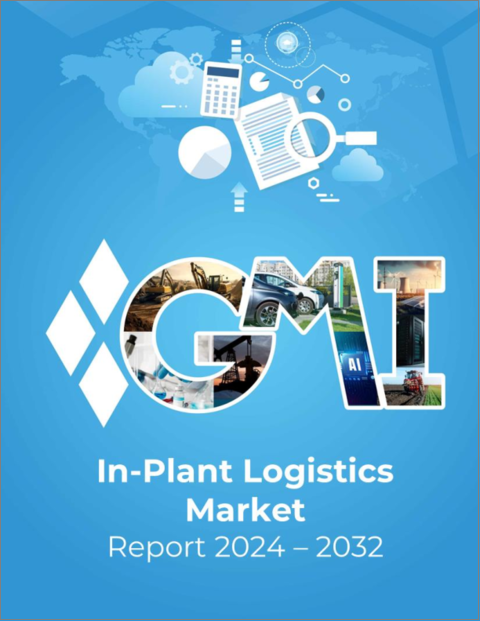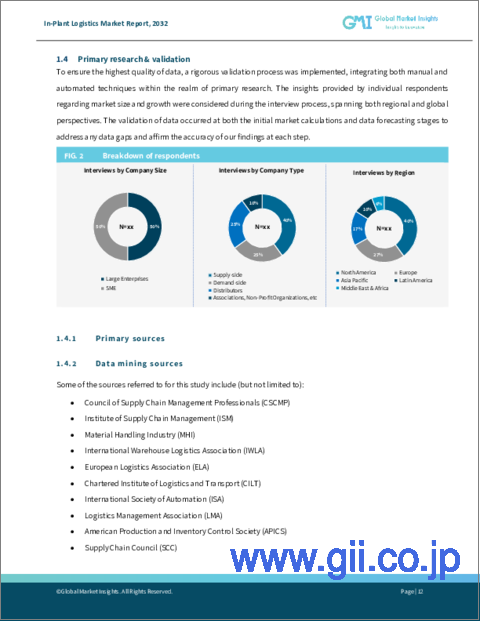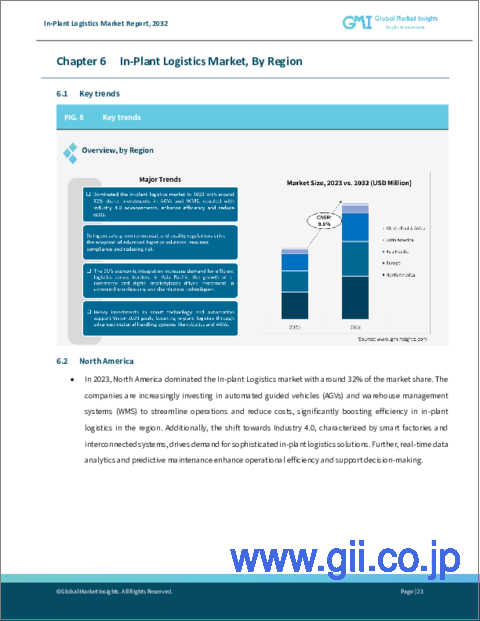|
|
市場調査レポート
商品コード
1577063
工場内物流市場、機会、成長促進要因、産業動向分析と予測、2024年~2032年In-Plant Logistics Market, Opportunity, Growth Drivers, Industry Trend Analysis and Forecast, 2024-2032 |
||||||
カスタマイズ可能
|
|||||||
| 工場内物流市場、機会、成長促進要因、産業動向分析と予測、2024年~2032年 |
|
出版日: 2024年08月07日
発行: Global Market Insights Inc.
ページ情報: 英文 260 Pages
納期: 2~3営業日
|
- 全表示
- 概要
- 目次
世界の工場内物流市場は、2023年に116億5,000万米ドルと評価され、2024年から2032年までのCAGRは10%を超える成長が予測されています。
この成長の原動力は、さまざまな産業で自動化とデジタル化の導入が進んでいることです。持続可能性と環境規制は、工場内物流市場の重要な促進要因です。企業は二酸化炭素排出量を削減し、厳しい環境法を遵守するため、環境に優しいソリューションを求めています。エネルギー消費を最小限に抑え、廃棄物を削減し、資源利用を改善する工場内物流システムの需要は高いです。こうした持続可能な実践は、環境保全に貢献するだけでなく、企業イメージやブランド価値の向上にもつながります。
製造プロセスにおける柔軟性と拡張性へのニーズも、市場の成長を後押ししています。市場がよりダイナミックになり、顧客の要求がより多様化するにつれ、企業は生産量や製品品種の変化に迅速に対応できるロジスティクス・システムを必要としています。
業界別では、自動車、小売・消費財、飲食品、金属・重機、エレクトロニクス、その他があります。自動車分野は、世界の人口増加と消費者所得の増加を背景に、2032年までに100億米ドルを超えると予想されています。メーカーは複雑なサプライチェーンを効率的に管理するため、高度なロジスティクス・ソリューションに投資しています。
導入形態別に見ると、市場はオンプレミス型、クラウド型、ハイブリッド型に分かれます。クラウドベースのセグメントが最も急成長しており、2024年から2032年までのCAGRは10%を超えます。クラウドベースのソリューションは、オンプレミスのソリューションに比べて拡張性が高く、先行投資が少ないため、工場内物流のダイナミックな環境では特に価値が高いです。
2023年の世界の工場内物流市場は、北米がシェアの35%以上を占めました。同地域の高度製造業は、大量生産と複雑なサプライチェーンを特徴としており、効率的なロジスティクス・ソリューションが求められています。自動化、ロボット工学、人工知能などの最先端技術の採用により、業務効率と精度が向上しています。米国市場は、その強固な製造部門と技術の進歩により繁栄しています。数多くの製造施設が自動化されたクラウドベースのロジスティクス・ソリューションに投資し、業務の合理化と効率化を図っています。
中国市場は、製造業の近代化とデジタル化を積極的に推進しているため、急速に拡大しています。スマート・マニュファクチャリングとインダストリー4.0の推進に対する政府のコミットメントが、高度なロジスティクス技術への投資を促進しています。
韓国市場は、テクノロジーとイノベーションを重視する同国の姿勢に後押しされ、力強い成長を遂げています。エレクトロニクスと自動車製造のリーダーとして、韓国はオートメーションとスマート工場技術に多額の投資を行っています。
日本の市場は、自動化と高度な製造技術に重点を置いていることから成長しています。ロボット工学、AI、IoT技術の物流業務への統合は、プロセスを合理化し、効率を向上させています。
目次
第1章 調査手法と調査範囲
第2章 エグゼクティブサマリー
第3章 業界洞察
- エコシステム分析
- サプライヤーの状況
- ソフトウェアプロバイダー
- ロジスティクス・サービス・プロバイダー
- テクノロジープロバイダー
- エンドユーザー
- 利益率分析
- テクノロジーとイノベーションの展望
- 特許分析
- 主要ニュースとイニシアチブ
- 規制状況
- 影響要因
- 促進要因
- インダストリー4.0とスマート工場の導入拡大
- 製造プロセスの複雑化
- 物流業界における技術の進歩
- 物流企業のコスト削減への関心の高まり
- 業界の潜在的リスク&課題
- 業務効率の課題
- サプライチェーンの混乱
- 促進要因
- 成長可能性分析
- ポーター分析
- PESTEL分析
第4章 競合情勢
- イントロダクション
- 企業シェア分析
- 競合のポジショニング・マトリックス
- 戦略展望マトリックス
第5章 市場推計・予測:サービスタイプ別、2021年~2032年
- 主要動向
- マテリアルハンドリング
- 輸送管理
- 在庫管理
- 包装・ラベリング
- その他
第6章 市場推計・予測:施設規模別、2021年~2032年
- 主要動向
- 小規模施設
- 中規模施設
- 大規模施設
第7章 市場推計・予測:エンドユーザー別、2021年~2032年
- 主要動向
- エレクトロニクス
- 飲食品
- 自動車
- 航空宇宙・防衛
- 化学
- その他
第8章 市場推計・予測:地域別、2021年~2032年
- 主要動向
- 北米
- 米国
- カナダ
- 欧州
- 英国
- ドイツ
- フランス
- イタリア
- スペイン
- 北欧
- その他欧州
- アジア太平洋
- 中国
- インド
- 日本
- 韓国
- ニュージーランド
- 東南アジア
- その他アジア太平洋地域
- ラテンアメリカ
- ブラジル
- メキシコ
- アルゼンチン
- その他ラテンアメリカ
- 中東・アフリカ
- 南アフリカ
- サウジアラビア
- アラブ首長国連邦
- その他中東・アフリカ
第9章 企業プロファイル
- Baumer
- Crown Equipment Corporation
- Daifuku Co., Ltd.
- Honeywell International, Inc.
- Interroll Group
- John Bean Technologies Corp.
- Jungheinrich AG
- KION Group AG
- Knapp AG
- KUKA AG
- Mecalux, S.A.
- Mitsubishi Logisnext Co., Ltd.
- Murata Machinery Ltd.
- SICK AG
- SSI Schafer
- TGW Logistics
- Toyota Industries Corporation
The Global In-Plant Logistics Market, valued at USD 11,650.0 million in 2023, is projected to grow at a CAGR exceeding 10% from 2024 to 2032. This growth is driven by the increasing adoption of automation and digitalization across various industries. Sustainability and environmental regulations are significant drivers for the in-plant logistics market. Companies are seeking eco-friendly solutions to reduce their carbon footprint and comply with stringent environmental laws. In-plant logistics systems that minimize energy consumption, reduce waste, and improve resource utilization are in high demand. These sustainable practices not only contribute to environmental conservation but also enhance corporate image and brand value.
The need for flexibility and scalability in manufacturing processes is also fueling market growth. As markets become more dynamic and customer demands more variable, companies require logistics systems that can quickly adapt to changing production volumes and product varieties.
By industry vertical, the market includes automobiles, retail & consumer goods, food & beverages, metals & heavy machinery, electronics, and others. The automobiles segment is expected to surpass USD 10 billion by 2032, driven by global population growth and rising consumer income. Manufacturers are investing in advanced logistics solutions to manage complex supply chains efficiently.
By deployment mode, the market is divided into on-premises, cloud-based, and hybrid solutions. The cloud-based segment is the fastest-growing, with a CAGR exceeding 10% from 2024 to 2032. Cloud-based solutions offer significant scalability and lower upfront investments compared to on-premises solutions, making them particularly valuable in the dynamic environment of in-plant logistics.
North America dominated the global in-plant logistics market in 2023, accounting for over 35% of the share. The region's advanced manufacturing sector, characterized by high production volumes and complex supply chains, demands efficient logistics solutions. The adoption of cutting-edge technologies such as automation, robotics, and artificial intelligence is enhancing operational efficiency and accuracy. The U.S. market is thriving due to its robust manufacturing sector and technological advancements. Numerous manufacturing facilities are investing in automated and cloud-based logistics solutions to streamline operations and enhance efficiency.
China's market is expanding rapidly due to the country's aggressive push towards manufacturing modernization and digitalization. The government's commitment to advancing smart manufacturing and Industry 4.0 is driving investments in advanced logistics technologies.
South Korea's market is experiencing robust growth, fueled by the country's strong emphasis on technology and innovation. As a leader in electronics and automotive manufacturing, South Korea is investing heavily in automation and smart factory technologies.
Japan's market is growing due to the country's focus on automation and advanced manufacturing techniques. The integration of robotics, AI, and IoT technologies into logistics operations is streamlining processes and improving efficiency.
Table of Contents
Chapter 1 Methodology and Scope
- 1.1 Research design
- 1.1.1 Research approach
- 1.1.2 Data collection methods
- 1.2 Base estimates and calculations
- 1.2.1 Base year calculation
- 1.2.2 Key trends for market estimation
- 1.3 Forecast model
- 1.4 Primary research and validation
- 1.4.1 Primary sources
- 1.4.2 Data mining sources
- 1.5 Market definitions
Chapter 2 Executive Summary
- 2.1 Industry 360° synopsis, 2021 - 2032
Chapter 3 Industry Insights
- 3.1 Industry ecosystem analysis
- 3.2 Supplier landscape
- 3.2.1 Software providers
- 3.2.2 Logistics service providers
- 3.2.3 Technology providers
- 3.2.4 End-user
- 3.3 Profit margin analysis
- 3.4 Technology and innovation landscape
- 3.5 Patent analysis
- 3.6 Key news and initiatives
- 3.7 Regulatory landscape
- 3.8 Impact forces
- 3.8.1 Growth drivers
- 3.8.1.1 Growing deployment of Industry 4.0 and smart factories
- 3.8.1.2 Increasing complexity of manufacturing processes
- 3.8.1.3 Technological advancements in the logistics industry
- 3.8.1.4 Growing focus of logistics companies on cost reduction
- 3.8.2 Industry pitfalls and challenges
- 3.8.2.1 Operational efficiency challenges
- 3.8.2.2 Supply chain disruptions
- 3.8.1 Growth drivers
- 3.9 Growth potential analysis
- 3.10 Porter's analysis
- 3.11 PESTEL analysis
Chapter 4 Competitive Landscape, 2023
- 4.1 Introduction
- 4.2 Company market share analysis
- 4.3 Competitive positioning matrix
- 4.4 Strategic outlook matrix
Chapter 5 Market Estimates and Forecast, By Service Type, 2021 - 2032 ($Bn)
- 5.1 Key trends
- 5.2 Material handling
- 5.3 Transportation management
- 5.4 Inventory management
- 5.5 Packaging and labelling
- 5.6 Others
Chapter 6 Market Estimates and Forecast, By Facility Size, 2021 - 2032 ($Bn, 000' tons)
- 6.1 Key trends
- 6.2 Small facilities
- 6.3 Medium facilities
- 6.4 Large facilities
Chapter 7 Market Estimates and Forecast, By End User, 2021 - 2032 ($Bn, 000' tons)
- 7.1 Key trends
- 7.2 Electronics
- 7.3 Food and beverage
- 7.4 Automotive
- 7.5 Aerospace and defense
- 7.6 Chemicals
- 7.7 Others
Chapter 8 Market Estimates and Forecast, By Region, 2021 - 2032 ($Bn, 000' tons)
- 8.1 Key trends
- 8.2 North America
- 8.2.1 U.S.
- 8.2.2 Canada
- 8.3 Europe
- 8.3.1 UK
- 8.3.2 Germany
- 8.3.3 France
- 8.3.4 Italy
- 8.3.5 Spain
- 8.3.6 Nordics
- 8.3.7 Rest of Europe
- 8.4 Asia Pacific
- 8.4.1 China
- 8.4.2 India
- 8.4.3 Japan
- 8.4.4 South Korea
- 8.4.5 ANZ
- 8.4.6 Southeast Asia
- 8.4.7 Rest of Asia Pacific
- 8.5 Latin America
- 8.5.1 Brazil
- 8.5.2 Mexico
- 8.5.3 Argentina
- 8.5.4 Rest of Latin America
- 8.6 MEA
- 8.6.1 South Africa
- 8.6.2 Saudi Arabia
- 8.6.3 UAE
- 8.6.4 Rest of MEA
Chapter 9 Company Profiles
- 9.1 Baumer
- 9.2 Crown Equipment Corporation
- 9.3 Daifuku Co., Ltd.
- 9.4 Honeywell International, Inc.
- 9.5 Interroll Group
- 9.6 John Bean Technologies Corp.
- 9.7 Jungheinrich AG
- 9.8 KION Group AG
- 9.9 Knapp AG
- 9.10 KUKA AG
- 9.11 Mecalux, S.A.
- 9.12 Mitsubishi Logisnext Co., Ltd.
- 9.13 Murata Machinery Ltd.
- 9.14 SICK AG
- 9.15 SSI Schafer
- 9.16 TGW Logistics
- 9.17 Toyota Industries Corporation






